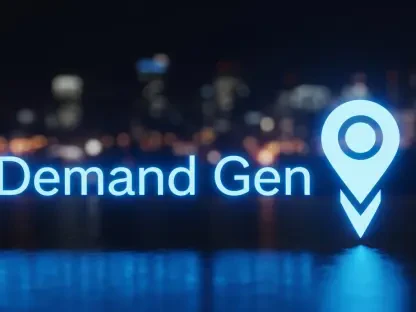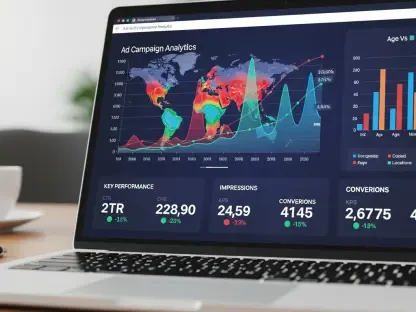Unpacking a Digital Powerhouse
Indonesia’s digital landscape is a phenomenon that demands attention, with a staggering 180 million social media users shaping a market that is as vibrant as it is vast. Representing 62.9% of the population, this figure reflects a 26% year-on-year growth, positioning the country as a global leader in online engagement. This market analysis delves into the forces behind this digital surge, exploring how social media, e-commerce, and emerging technologies are transforming consumer behavior and economic dynamics. The purpose of this examination is to provide actionable insights for businesses aiming to navigate and capitalize on one of the world’s most dynamic digital ecosystems.
Market Trends and In-Depth Analysis
Social Media Dominance and Consumer Influence
Social media is not just a trend in Indonesia; it is the backbone of daily interaction and decision-making for millions. With users spending an average of 22 hours weekly online across 7.7 platforms, platforms like WhatsApp, TikTok, and YouTube are central to communication and entertainment. Data reveals that while search engines lead brand discovery at 38.3%, social media ads are a close second at 37.3%, with user comments influencing 32.6% of decisions. This highlights the critical role these platforms play in shaping consumer preferences, as nearly 60% of internet users rely on them for brand research.
The implications for businesses are clear: presence on these platforms is non-negotiable. Engagement with sponsored content is notable, with 20% of users interacting with such posts monthly. However, cultural resonance remains a challenge, as campaigns must align with local values to avoid being lost in the noise of a crowded digital space. This necessitates a deep understanding of audience behavior and platform-specific strategies to maximize impact.
E-Commerce Boom and Mobile-First Dynamics
Indonesia’s e-commerce sector is experiencing explosive growth, driven by 99 million online shoppers who predominantly use mobile devices for transactions. The food category alone generates an annual revenue of $13 billion, underscoring how social media often serves as a gateway to purchasing decisions. Compared to global markets, Indonesia’s mobile-first approach is more pronounced, offering unique opportunities for targeted marketing campaigns that leverage this trend.
Yet, challenges loom large, particularly around trust. A significant 56.1% of users express concern over distinguishing real from fake content online, which can erode confidence in digital transactions. Businesses must address these issues by prioritizing transparency and authenticity in their digital interactions to build lasting relationships with consumers. This mobile-driven market also calls for optimized user experiences tailored to smaller screens and faster decision-making cycles.
Technological Innovations and Regional Variations
Emerging technologies are reshaping Indonesia’s digital landscape at a rapid pace. Over a third of the population uses generative AI tools monthly, contributing to 80.6% of AI-related web traffic in the region. This appetite for innovation signals a tech-savvy user base, eager to adopt new tools that enhance online experiences. However, disparities in access and digital literacy between urban centers like Jakarta and rural areas create a fragmented market that demands localized approaches.
Advertising spend reflects this digital momentum, with projections indicating a robust increase, particularly in social media ads growing at 11.3% and influencer campaigns at 14.4% annually from 2025 onward. TikTok stands out with the highest ad reach, while specific demographics, such as males aged 25-34, remain key targets for other major platforms. These trends suggest that businesses must balance technological adoption with an awareness of regional nuances to craft effective engagement strategies.
Future Projections and Economic Shifts
Looking toward the coming years, Indonesia’s digital trajectory shows sustained growth potential. The rise in middle-class spending power is expected to further fuel e-commerce and online engagement, creating a fertile ground for market expansion. Technological advancements, including wider AI integration, are likely to redefine how consumers interact with brands, pushing companies to innovate continuously.
Regulatory changes around data privacy and misinformation are anticipated to influence the digital space significantly. These shifts could impose new compliance requirements, urging businesses to remain agile and proactive in adapting their strategies. The convergence of economic growth and technological progress paints a promising picture, provided stakeholders navigate these evolving dynamics with foresight and precision.
Reflecting on Insights and Strategic Pathways
This analysis of Indonesia’s digital market reveals a landscape defined by 180 million social media users, a thriving e-commerce sector, and rapid technological adoption. The examination underscores the profound influence of platforms on consumer behavior and the economic potential embedded in mobile-first trends. Challenges like misinformation and regional disparities add layers of complexity to an otherwise opportunity-rich environment.
Moving forward, businesses are encouraged to prioritize cultural alignment and platform-specific tactics to engage effectively with this dynamic audience. Strategic investments in local influencer partnerships and data analytics emerge as critical steps to address diverse regional needs. Additionally, fostering trust through transparent communication stands out as a vital measure to counter misinformation concerns. These actionable pathways offer a roadmap for companies to harness Indonesia’s digital potential and achieve sustainable growth in a competitive market.









